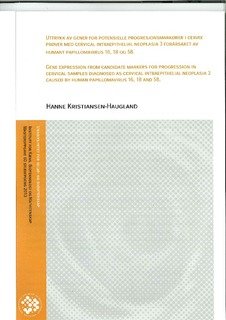| dc.description.abstract | Livmorhalskreft
er
en
av
de
mest
forekommende
krefttypene
hos
kvinner.
Flere
enn
500.000
tilfeller
blir
diagnostisert
hvert
år
og
på
verdensbasis
dør
omtrent
275.000
kvinner
årlig
av
denne
kreftformen.
Det
er
nå
vist
at
persisterende
infeksjon
med
bestemte
høy
risiko
typer
av
HPV,
er
en
nødvendig
årsak
til
utvikling
av
livmorhalskreft.
HPV
assosierte
celleforandringer
kan
gå
i
regress.
90
%
av
alle
HPV
infeksjoner
vil
klareres
innen
2-‐4
år.
Mindre
enn
50
%
av
tilfellene
med
høygradig
celleforandring
progredierer
til
å
bli
invasivt
karsinom
og
utvikles
via
forstadier
til
kreft
som
regel
over
10-‐20
år.
I
dag
benyttes
screeningprogrammer
med
cytologi
i
primærscreening
og
HPV
DNA
testing
i
enkelt
tilfeller,
for
å
oppdage
tilfeller
med
celleforandring
og
livmorhalskreft.
Å
finne
molekylære
markører
som
kan
skille
ut
pasienter
med
en
høy
risiko
for
progresjon,
vil
være
svært
verdifullt.
For
eksempel
er
mRNA
testing
for
HPV
E6
og
E7
sannsynligvis
en
bedre
progresjonsmarkør
enn
påvisning
av
viralt
DNA
for
å
finne
de
tilfeller
som
vil
kunne
utvikles
til
livmorhalskreft.
Hensikten
med
oppgaven
har
vært
å
avdekke
mulige
forskjeller
i
genuttrykk
av
både
virale
onkogener
og
cellulære
gener
med
biomarkør
potensiale
på
lesjoner
med
samme
alvorlighetsgrad,
som
skyldes
ulike
HPV
typer.
Masteroppgaven
er
basert
på
analyse
av
konisert
vev
fra
livmorhalsen
som
er
samlet
inn
i
forbindelse
med
et
tverrfaglig
HPV
prosjekt
ved
Akershus
Universitetssykehus
i
tidsrommet
2005-‐2009.
Pasienter
hvor
cytologisk
prøve
er
positiv
for
kun
en
HPV
type,
enten
16,
18
eller
58,
og
histologiprøven
er
diagnostisert
med
CIN3
ble
valgt
ut.
For
å
studere
det
spesifikke
genuttrykket
for
områder
med
lesjon,
ble
det
benyttet
lasermikrodisseksjon
(LCM).
De
virale
onkogenene
HPV
E6
og
E7,
samt
de
humane
genene
p16/CDKN2A,
Serpin
B5,
TMEM
45A
og
hTERT
ble
undersøkt
i
studien.
Resultatene
viser
at
det
relative
uttrykket
av
de
to
onkogener
skiller
seg
markant
ut
mellom
HPV
16
positive
prøver,
og
de
to
andre
HPV
typene.
Det
var
til
gjengjeld
ingen
signifikante
forskjeller
for
uttrykkene
mellom
prøver
positive
for
HPV
18
og
58.
For
de
cellulære
genene
p16/CDKN2A
og
TMEM45
ble
det
avdekket
et
signifikant
høyere
uttrykk
i
HPV
58
positive
prøver
sammenlignet
mot
HPV
16.
De
andre
cellulære
genene,
Serpin
B5,
viste
ingen
signifikante
forskjeller
mellom
de
ulike
HR
HPV
typene
mens hTERT
ikke
ble
konsekvent
uttrykt
i
de
ulike
HR
HPV
positive
prøver.
Våre
funn
viser
at
studier
for
identifisering
av
progresjonsmarkører
utført
på
HPV
16
positive
prøver
bør
verifiseres
for
andre
HR-‐HPV. Cervical
cancer
is
one
of
the
most
commonly
occurring
cancer
types
in
women.
More
than
530,000
cases
are
diagnosed
each
year
worldwide
and
close
to
275,000
women
die
of
this
cancer
each
year.
It
is
now
known
that
persistent
infection
with
certain
high-‐risk
types
of
HPV
is
a
necessary
cause
of
cervical
cancer.
HPV-‐associated
cervical
dysplasia,
can
go
to
regress.
90
%
of
all
HPV
infections
will
be
cleared
within
2-‐4
years.
Less
than
50
%
of
cases
with
high-‐grade
cervical
dysplasia
progress
to
become
invasive
carcinoma
and
that
develop
normally
over
10-‐20
years.
Today
in
Norway,
currently
used
screening
programs
with
cytology
in
primary
screening
and
HPV
DNA
testing
in
individual
cases,
are
used
to
detect
precancerous
lesions
and
cervical
cancer.
To
find
molecular
markers
that
can
distinguish
patients
with
a
high
risk
of
progression,
will
be
very
valuable.
For
example
will
mRNA
testing
for
HPV
E6
and
E7
probably
be
a
better
marker
for
progression
than
the
detection
of
viral
DNA
in
order
to
detect
cases
who
will
be
at
more
risk
to
develop
cervical
cancer.
The
purpose
of
the
study
was
to
study
gene
expression
of
viral
oncogenes
and
candidate
biomarker
cellular
genes
in
lesions
with
the
same
histological
diagnosis,
but
caused
by
different
HPV
types,
with
different
association
to
progression.
The
thesis
is
performed
on
analysis
of
cervical
tissue
after
conisation
that
is
collected
in
connection
with
an
interdisciplinary
HPV
project
at
Akershus
University
Hospital
in
the
period
2005-‐2009.
Patients
in
whom
cervical
smear
is
positive
for
only
one
HPV
type,
either
16,
18
or
58,
and
histology
is
diagnosed
with
CIN3
were
selected.
To
study
the
gene
expression
of
specific
areas
of
the
lesion,
there
were
used
lasercapturemicrodissection
(LCM).
The
viral
oncogenes
E6
and
E7
HPV
and
the
human
genes
p16/CDKN2A,
Serpin
B5,
TMEM
45A
and
hTERT
were
examined
in
the
study.
The
results
indicate
that
the
relative
expression
of
the
two
oncogenes
differs
markedly
from
HPV
16
positive
samples
and
the
other
two
HPV
types.
There
were
no
significant
differences
in
return
for
expressions
between
HPV
18
and
58.
The
cellular
genes
p16/CDKN2A
and
TMEM45
revealed
a
significant
higher
expression
in
HPV
58
positive
samples
compared
to
HPV
16.
The
other
human
genes,
Serpin
B5,
showed
no
significant
difference
between
the
different
HR
HPV
types
while
hTERT
were
not
consistently expressed
in
samples
of
different
HR
HPV
type.
Our
findings
indicate
that
studies
for
identification
of
progression
markers
for
HPV
16
positive
samples
should
be
verified
for
other
HR
HPV
types. | no_NO |
